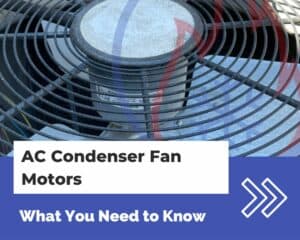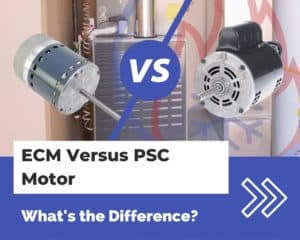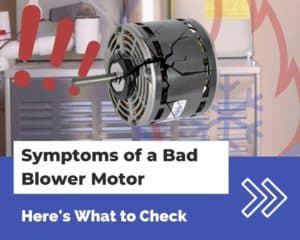In recent years, there have been many advances in HVAC technology.
One of those advances is the use of ECM motors.
But what are ECM motors anyway? And how do they affect your furnace or AC unit?
An ECM motor is a brushless DC motor that is capable of adjusting its speed and torque. By using a controller, an ECM is programmable and maintains energy efficiency across a wide range of speeds.
In this article, I’ll go over what an ECM motor is and how it works. I’ll also discuss the different types of ECM motors and what they are used for.
How does an ECM motor work?
An ECM (Electronically Commutated Motor) is a brushless DC motor that is controlled by a microprocessor.
An ECM motor has two main parts:
- A brushless DC motor
- A controller
The ECM motor works by energizing a series of electromagnets inside of the motor’s stator. The electromagnets are activated in a circular fashion to rotate the motor’s rotor.
The ECM’s controller is the part that’s responsible for sending power to the motor’s electromagnets.
The controller can be programmed for different types of operations. Each manufacturer will program the ECM depending on what the motor will be used for.
For example, an ECM could be programmed to maintain constant airflow for a furnace blower. Or an ECM could be programmed to maintain a constant speed for an AC condenser fan.
Below is a video from Lesics that provides an animation of a brushless DC motor in action.
I’ll talk about the different types of ECMs below.
ECM motor types
The brushless DC motor inside of an ECM allows for a variety of control methods.
In HVAC applications, there are three main types of ECM motors:
- Constant torque
- Constant airflow
- Constant speed
Constant torque ECM
A constant torque ECM is programmed to maintain the same amount of torque regardless of static pressure.
For example, if the pressure increases in the HVAC system, then a constant torque ECM will increase its power to maintain the same torque.
How does a constant torque ECM differ from a PSC motor?
A constant torque ECM will maintain more airflow than a PSC when there is air restriction in an HVAC system.
However, a constant torque ECM will still lose some airflow due to air restriction—just not as much as a PSC.
Where is a constant torque ECM used?
Constant torque ECMs are commonly used as blowers in air handlers. They can be used as replacements for PSC motors since they are more efficient and cost less than other types of ECM motors.
Constant airflow ECM
Constant airflow ECMs are also known as constant CFM or variable speed.
A constant airflow ECM is programmed to maintain the same amount of airflow regardless of static pressure.
For example, if the pressure increases in the HVAC system, then a constant airflow ECM will increase its torque and speed to maintain the same airflow.
How does a constant airflow ECM differ from a constant torque ECM?
A constant airflow ECM will maintain the same airflow regardless of air restrictions in the HVAC system. Whereas a constant torque ECM will lose some airflow due to air restriction.
Where is a constant airflow ECM used?
Constant airflow ECMs are used in high-efficiency furnaces and ACs.
Unlike constant torque and constant speed ECMs, constant airflow ECMs are true variable speed motors. This allows a constant airflow ECM to deliver precise amounts of airflow.
For example, if the filter in the air handler gets dirty, the heating or cooling capacity of the HVAC unit will remain unaffected.
Constant speed ECM
Constant speed ECMs are also known as constant RPM.
A constant speed ECM is programmed to maintain the same speed regardless of static pressure.
For example, if air restriction is introduced into a system, a constant speed ECM will increase its torque to maintain the same speed.
How does a constant speed ECM differ from a constant torque ECM?
A constant speed ECM will maintain the same speed regardless of air restrictions in the HVAC system.
Whereas a constant torque ECM will lose some speed due to air restriction.
Where is a constant speed ECM used?
Constant speed ECMs are typically used for AC condenser fans. Constant speed ECMs are used in AC condensers because they allow the equipment manufacturer to tweak the fan blade shape to maintain sufficient airflows at low speeds.




Trey:
I am building a new house that is very energy efficient. Low ACH, high insulation etc. , with a walk out basement and a main level. I would like to use one air handler and two dampers, one for the basement the other for the main floor. The problem arises according to the manual J the basement about 1/2 the BTUs compared to the main floor. I would like to use a variable speed (ECM) HVAC unit. Will an ECM air handler be able to compensate when both dampers are open as opposed to just one floor calling for air conditioning?
Hi Terry,
It’s great that you’re taking energy efficiency into account when building your new house.
You should consult with your builder and HVAC company, but generally speaking the ECM should ramp up and down based on the damper positions. For example, here are three possible scenarios:
1. Both dampers are open – fan motor runs at 100%
2. Main floor damper is open, basement damper is closed – fan motor runs at 66%
3. Main floor damper is closed, basement damper is open – fan motor runs at 33%
The controller on the ECM motor that you use will need to be able to take a variable input signal to adjust its speed according to the damper positions.
Another thing to keep in mind is that your AC condenser unit will need to be able to ramp or stage up/down according to the damper positions. When one zone damper is closed, the cooling load will change so your condenser unit will need to respond accordingly. Or else your condenser unit will short cycle and wear itself out.
Hope this helps
-Trey
Terry, Thank you, very informative write up on ECM motor types.
We are in process of replacing our 20+ year HVAC 80%-10 SEER system. Key question i have is on blower, will variable speed motor save energy ? dose it draw less Amps overall ? We have 2 zone controlled separately.
Hi Shailesh,
What it depends on is if the energy savings from getting a variable speed motor will offset its installation cost. It’s different for every home – for some it will be worth it (especially if they use their system a lot and have a big home). For others it won’t be worth it.
I wrote another artice discussing the differences between PSC and ECM motors, you might find it helpful: https://hvactrainingshop.com/ecm-versus-psc-motor/
-Trey
Hi Trey-
I am a homeowner in the middle of a Chicago deep freeze. I have had an HVAC technician working on my system. We’ve lived in this house for 4 winters now. Starting this winter—it just doesn’t feel like hot air is being pushed through the HVAC vents to the rooms. It’s currently 50 degrees on the 1st floor of my house. We have 5 thermostats on the 1st floor. They control the radiators, baseboards and floor vents in some areas. The radiators and baseboards are hot but the vents have no hot air. There are 6 pumps and valves in the boiler room that control the different rooms or zones. The boiler works, the pumps and valves are working. And there is hot air in the air handler (when I take the cover off the Bryant humidifier there is hot air). My question is —thus last summer, we removed the Weil-McLain boiler and installed an Alta boiler for DHW and hydronic heating (only on the 1st floor-there is a furnace in the attic that heats the 2nd and 3rd floors). Is the new boiler not compatible with the ECM motor in the air handler? Would that be the problem? There has to be a reason that this is the 1st winter that we are having issues with hot air being blown to the zones. Is this not how air handlers/blower motors work in hydronic heating systems? I only ask because you layout the different ECM motors and their applications and you say that certain (constant speed) ECM motors would be used with high-efficiency furnaces. The technician is coming over again this morning to look at my system.
Hi Anne,
There are many factors that could be at play. The blower motor being an ECM has no effect on whether or not it will work in your system. However, the ratings and programming of the motor do have an effect.
The company that installed the ECM should have ensured that it is set up and programmed properly to work with your specific system.
Also keep in mind that it could be some other part of your system that is having issues keeping your home warm.
-Trey